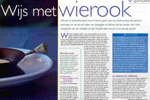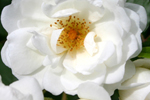
Wierook maken in beeld |

Wierook in de media |

Bloemen en hun betekenis |

Geuromschrijvingen |
The Smell Report: Vanilla
Datum: 19 juni 2015 | Bron: http://www.sirc.org/publik/smell_vanilla.html (hoofdstuk van The Smell Report)

In the early 1990s, perfume makers began to introduce vanilla as a significant note in their fragrances. Now, vanilla is a dominant ingredient in a large number of perfumes – and the Body Shop have recently launched a pure vanilla fragrance.
Various attempts have been made to explain the current unprecedented popularity of vanilla-based fragrances. Many have tended to focus on the pleasant childhood memories associated with the smell of vanilla, its comforting milky warmth. Others have noted the appropriateness of vanilla scents for the 'softer, more caring' zeitgeist of the 1990s – as opposed to the thrusting, bullish 80s, when the fashion was for perfumes so overpowering that restaurants had to ban them because customers could not taste their food.
Both of these factors have clearly contributed to the vanilla-boom. Scientists have been studying the intimate connection between olfaction and memory for some time – and the power of scents to evoke vivid memories has long been a favourite device of novelists and poets. Proust's Remembrance of Things Past opens with the most famous 'olfactory flashback' in literature, when the sweet aroma of a simple little cake releases several hundred pages of childhood memories – or what Proust calls 'the vast structure of recollection'.
A recent experiment has shown that most of us, unlike Proust, have some difficulty in expressing this vast structure of recollection in words. Subjects were presented with visual (an object), lexical (the name of an object) and olfactory (the odour of an object) stimuli, and asked to write down whatever came into their heads. Written responses to the visual and lexical stimuli were much longer than those for the olfactory mode, but responses to the odours were far more emotive, and all referred to memories. Not all childhood memories are pleasant, of course, but those associated with vanilla are almost invariably positive – sweet treats and rewards, ice-cream holidays, innocent pleasures, etc. – which certainly helps to explain its popularity.
The 1990s-zeitgeist explanation also has its merits. Vanilla is associated not only with warmth, softness and caring, but also has connotations of purity and simplicity. The term 'plain vanilla', used by typesetters and graphic designers, means 'untouched' text – text in its natural, basic, original state, before designers have tarted up the headings, adjusted the margins, tinkered with typefaces, etc. This term is now often used outside the publishing world, and anything that is simple, pure, honest and unadulterated may be referred to as 'plain vanilla'. The Body Shop's vanilla fragrance, being pure vanilla with no other scents, is perhaps the most faithful expression of 1990s values.
Yet there is hard scientific evidence to indicate that the popularity of vanilla fragrances could be more enduring than these explanations suggest. The scent of vanilla has proven positive and beneficial effects which have nothing to do with current fashion, changing values or even childhood memories.
For example:
Psychologists and medical researchers were aware of our positive reactions to the scent of vanilla long before perfume makers recognised its potential. In experiments where an odour universally regarded as 'pleasant' is required, vanillin has been a standard choice for decades.
Medical experiments have shown that vanilla fragrance reduces stress and anxiety. Cancer patients undergoing Magnetic Resonance Imaging – a diagnostic procedure known to be stressful – reported a massive 63% less anxiety when heliotropin (a vanilla fragrance) was administered during the procedure.
Vanilla fragrance makes you calmer. A study at Tubingen University in Germany showed that vanilla fragrance reduced the startle-reflex in both humans and animals. The animal results indicate that the calming effects of vanilla may be due to some more essential property of the fragrance than the 'positive childhood associations' usually invoked to explain its universal popularity with humans.
It is important to remember that these effects have only been documented for pure vanilla fragrance – not perfumes containing a blend of vanilla and other notes.
|




